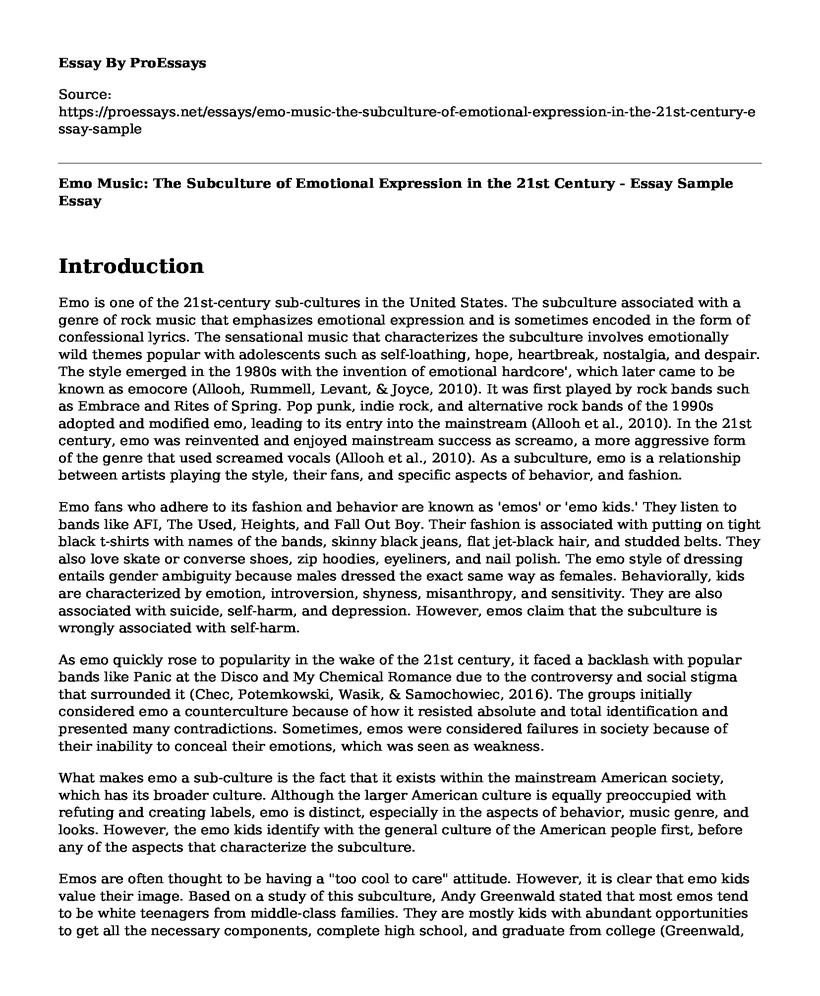Introduction
Emo is one of the 21st-century sub-cultures in the United States. The subculture associated with a genre of rock music that emphasizes emotional expression and is sometimes encoded in the form of confessional lyrics. The sensational music that characterizes the subculture involves emotionally wild themes popular with adolescents such as self-loathing, hope, heartbreak, nostalgia, and despair. The style emerged in the 1980s with the invention of emotional hardcore', which later came to be known as emocore (Allooh, Rummell, Levant, & Joyce, 2010). It was first played by rock bands such as Embrace and Rites of Spring. Pop punk, indie rock, and alternative rock bands of the 1990s adopted and modified emo, leading to its entry into the mainstream (Allooh et al., 2010). In the 21st century, emo was reinvented and enjoyed mainstream success as screamo, a more aggressive form of the genre that used screamed vocals (Allooh et al., 2010). As a subculture, emo is a relationship between artists playing the style, their fans, and specific aspects of behavior, and fashion.
Emo fans who adhere to its fashion and behavior are known as 'emos' or 'emo kids.' They listen to bands like AFI, The Used, Heights, and Fall Out Boy. Their fashion is associated with putting on tight black t-shirts with names of the bands, skinny black jeans, flat jet-black hair, and studded belts. They also love skate or converse shoes, zip hoodies, eyeliners, and nail polish. The emo style of dressing entails gender ambiguity because males dressed the exact same way as females. Behaviorally, kids are characterized by emotion, introversion, shyness, misanthropy, and sensitivity. They are also associated with suicide, self-harm, and depression. However, emos claim that the subculture is wrongly associated with self-harm.
As emo quickly rose to popularity in the wake of the 21st century, it faced a backlash with popular bands like Panic at the Disco and My Chemical Romance due to the controversy and social stigma that surrounded it (Chec, Potemkowski, Wasik, & Samochowiec, 2016). The groups initially considered emo a counterculture because of how it resisted absolute and total identification and presented many contradictions. Sometimes, emos were considered failures in society because of their inability to conceal their emotions, which was seen as weakness.
What makes emo a sub-culture is the fact that it exists within the mainstream American society, which has its broader culture. Although the larger American culture is equally preoccupied with refuting and creating labels, emo is distinct, especially in the aspects of behavior, music genre, and looks. However, the emo kids identify with the general culture of the American people first, before any of the aspects that characterize the subculture.
Emos are often thought to be having a "too cool to care" attitude. However, it is clear that emo kids value their image. Based on a study of this subculture, Andy Greenwald stated that most emos tend to be white teenagers from middle-class families. They are mostly kids with abundant opportunities to get all the necessary components, complete high school, and graduate from college (Greenwald, 2003). That is why they have time to think about the 'problems,' which usually are blown out of proportion for them in songs and other aspects of the subculture.
Lastly, like other subcultures, emo had its argot, which included words and phrases like moshing (a type of dance common with the genre, in which fans slam into one another), tweemo (twin emo), I got a new cat (a phrase used as excuse for anything), tramming (complaining too much or to be stuck in the state of being emo), my space (a solitary place where an emo can get some rest) (Chec, et al., 2016).
References
Allooh, N. N., Rummell, C. M., Levant, R. F., & Joyce, N. R. (2010). Examining the "EMO" Culture in College Students. PsycEXTRA Dataset. doi:10.1037/e628802010-001
Chec, M., Potemkowski, A., Wasik, M., & Samochowiec, A. (2016). Parental attitudes and aggression in the Emo subculture. Psychiatria Polska, 50(1), 19-28. doi:10.12740/pp/36316
Greenwald, A. (2003). Nothing Feels Good: Punk Rock, Teenagers, and Emo. London: Macmillan.
Cite this page
Emo Music: The Subculture of Emotional Expression in the 21st Century - Essay Sample. (2023, Mar 29). Retrieved from https://proessays.net/essays/emo-music-the-subculture-of-emotional-expression-in-the-21st-century-essay-sample
If you are the original author of this essay and no longer wish to have it published on the ProEssays website, please click below to request its removal:
- An Evaluation of the Benefits of Journaling - Essay Sample
- Critical Essay on Picasso's Demoiselles D'Avignon
- Impact of Alzheimer Disease on Family Patients Paper Example
- Effects of Social Media on Young People - Essay Sample
- Paper Example on Creating an Effective Security Plan Using an Enterprise Architecture
- Essay on How Walt Disney Ruined Our Love Lives: The Impact on Modern Romantic Relationships
- Ethnic Identity Construction in US via Art Theatre Movement - Research Paper







